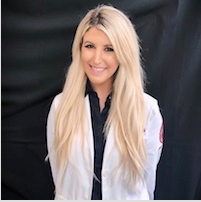Review: The Safety of Punch Biopsies on Hard-to-Heal Wounds: A Large Multicentre Clinical Trial
March 24, 2021
By Temple University School of Podiatric Medicine Journal Review Club
Editor's note: This post is part of the Temple University School of Podiatric Medicine (TUSPM) journal review club blog series. In each blog post, a TUSPM student will review a journal article relevant to wound management and related topics and provide their evaluation of the clinical research therein.
Article: The Safety of Punch Biopsies on Hard-to-Heal Wounds: A Large Multicentre Clinical Trial
Authors: Serena T, Cole W, Harrell S, et al.
Journal: J Wound Care. 2020;29:S4-S7
Reviewed by: Melissa Muroski, class of 2021, Temple University School of Podiatric Medicine
Introduction
The challenges of treating lower extremity wounds for podiatrists can feel more often like a marathon than a sprint. Complex and chronic wounds can add further stress on the patient and physician alike and make this marathon feel entirely uphill. In suspiciously slow-healing chronic wounds, narrowing down the specific diagnosis, the presence of a neoplasm, and/or the bacterial load analysis can drastically alter the treatment options.
A punch biopsy procedure is a useful and informative diagnostic technique that can be used to address all of the previously listed concerns and further focus the treatment of such challenging wounds. Although the punch biopsy seems as though it should be a standard diagnostic tool, many providers are hesitant to use it because it is an invasive procedure. Given that the patient’s safety is always of the upmost importance in creating a treatment plan, a multicenter clinical trial was designed to observe the incidence of complications associated with performing punch biopsy procedures in chronic open wounds.1
Managing Wound Infection: Opportunities in Antimicrobial Stewardship
Methods
This observational clinical trial was conducted with 350 patients, 412 total punch biopsies, and 20 investigators in 14 different US sites. Three different evaluation methods were used to assess the amount of bacterial burden in each patient: clinical signs and symptoms, fluorescence imaging, and quantitative tissue culture biopsy. When the investigator suspected that an area of the wound had moderate to heavy levels of bacteria on the basis of clinical signs or fluorescence imaging, a 6-mm biopsy sample was obtained from the region(s) of concern. The biopsy specimens were all obtained by adhering to the same protocol of cleansing of the area, administration of local anesthesia, and hemostasis achieved with direct pressure. The patient was followed up for 30 days after the punch biopsy to monitor any post-procedural complications.
Results
Of the 412 total 6-mm biopsies performed in this trial, only one patient had a complication. This adverse event was discussed in detail, and the resultant complication of infection was quickly reversed with antibiotics and could not be completely related to the punch biopsy procedure itself. The patient in question presented with other underlying health issues that could have potentially increased their risk for infection.
Conclusion
The research trial concluded that punch biopsy is a simple and safe tool to use in the diagnosis and treatment of chronic, hard-to-heal lower extremity wounds. This article also used the study results to diminish any hesitation and promote punch biopsy as a standard procedure in the treatment of chronic wounds. Although it can be overly optimistic to think that this one clinical trial can convince all podiatrists to begin using punch biopsies in every complicated wound, the article does a great job at beginning the conversation. The investigators also noted that this trial failed to evaluate the connection between punch biopsies and healing rate because it assessed wounds only for 30 days post-biopsy. Although the authors acknowledged this limitation, they quickly announced their plans for a retrospective study to investigate whether the punch biopsies performed influenced the rate of healing.
Reference
- Serena T, Cole W, Harrell S, et al. The safety of punch biopsies on hard-to-heal wounds: a large multicentre clinical trial. J Wound Care. 2020;29:S4-S7. 10.12968/jowc.2020.29.Sup2c.S4.
- Stevenson P, Rodins K. Improving diagnostic accuracy of skin biopsies. Aust J Gen Pract. 2018;47(4):216-220. https://doi.org/10.31128/AFP-10-17-4376
About The Author
 Melissa Muroski is a third-year podiatric medical student at Temple University School of Podiatric Medicine (TUSPM) in Philadelphia, Pennsylvania. She graduated from Fairfield University in Fairfield, Connecticut in 2015 as a member of the Honor’s Program with a Bachelor of Science in Psychology. Melissa began studying at TUSPM in the fall of 2017. Throughout her third year of clinical rotations, Melissa found a profound interest in the field of wound care and helping those patients who are affected by lower extremity wounds. As an upcoming extern, Melissa is eager to begin her clinical training and continue to explore the most up-to-date podiatric research to ensure her patients receive the finest care. Dr. James McGuire is the director of the Leonard S. Abrams Center for Advanced Wound Healing and an associate professor of the Department of Podiatric Medicine and Orthopedics at the Temple University School of Podiatric Medicine in Philadelphia.
Melissa Muroski is a third-year podiatric medical student at Temple University School of Podiatric Medicine (TUSPM) in Philadelphia, Pennsylvania. She graduated from Fairfield University in Fairfield, Connecticut in 2015 as a member of the Honor’s Program with a Bachelor of Science in Psychology. Melissa began studying at TUSPM in the fall of 2017. Throughout her third year of clinical rotations, Melissa found a profound interest in the field of wound care and helping those patients who are affected by lower extremity wounds. As an upcoming extern, Melissa is eager to begin her clinical training and continue to explore the most up-to-date podiatric research to ensure her patients receive the finest care. Dr. James McGuire is the director of the Leonard S. Abrams Center for Advanced Wound Healing and an associate professor of the Department of Podiatric Medicine and Orthopedics at the Temple University School of Podiatric Medicine in Philadelphia.
The views and opinions expressed in this blog are solely those of the author, and do not represent the views of WoundSource, HMP Global, its affiliates, or subsidiary companies.










Follow WoundSource
Tweets by WoundSource